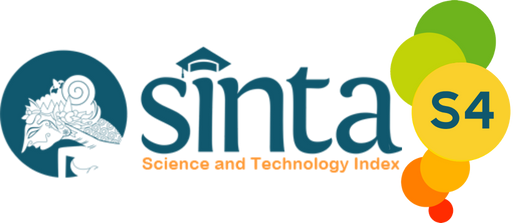Menguji Kesiapan Belajar Siswa Berbasis High Order Thinking Skill di Indonesia
Abstract
Even though HOTS-based learning has been implemented since 2018, students' readiness has not been tested. This study aims to test the willingness of students to learn based on HOTS in Indonesia. Readiness is reviewed based on the 4C criteria: critical thinking, creative, communicative, and collaborative. This study uses a descriptive quantitative approach. The sample was selected by random cluster sampling of 2.645 Indonesian students. The test method uses a questionnaire and observation. Data were taken by using observation, interview, and questionnaire techniques. The results show that students look active during discussions but still find it challenging to develop their creativity to solve problems. In quizzes, students should start to get used to the thinking process at levels C4 to C6, but students still choose C1 to C3. This study concludes that students are ready for criteria C1 to C3 and unprepared for learning at levels C4 to C6. Students need intense coaching and mentoring to support the successful implementation of HOTS-based learning.
Keywords
Full Text:
PDF (Bahasa Indonesia)References
Al-Balushi, S., & Ambusaidi, A. (2017). Using Drawing to Reveal Science Teachers’ Beliefs about Science Teaching. In Drawing for Science Education (pp. 179–189). SensePublishers. https://doi.org/10.1007/978-94-6300-875-4_16
Al-Balushi, S. M., Ambusaidi, A. K., Al-Balushi, K. A., Al-Hajri, F. H., & Al-Sinani, M. S. (2020). Student-centred and teacher-centred science classrooms as visualized by science teachers and their supervisors. Teaching and Teacher Education, 89, 103014. https://doi.org/10.1016/j.tate.2019.103014
Ambusaidi, A. K., & Al-Balushi, S. M. (2012). A Longitudinal Study to Identify Prospective Science Teachers’ Beliefs about Science Teaching Using the Draw-a-Science-Teacher-Test Checklist. International Journal of Environmental and Science Education, 7(2), 291–311.
Ariyana, Y., Pudjiastuti, A., Bestary, R., & Zamromi, Z. (2018). Buku pegangan pembelajaran keterampilan berpikir tingkat tinggi berbasis zonasi. Direktorat Jendral Guru Dan Tenaga Kependidikan, 1–87.
Center, P. P. R. (2010). 21st Century Skills for Students and Teachers. Honolulu: Kamehameha Schools. Research & Evaluation Division.
Curtis, E., Lunn Brownlee, J., & Spooner-Lane, R. (2020). Teaching perspectives of philosophical inquiry: Changes to secondary teachers’ understanding of student learning and pedagogical practices. Thinking Skills and Creativity, 38, 100711. https://doi.org/10.1016/j.tsc.2020.100711
Doringin, F. (2017). Kurikulum Baru, Ketrampilan Abad 21 dan Implementasinya. https://pgsd.binus.ac.id/2017/08/08/kurikulum-baru-ketrampilan-abad-21-dan-implementasinya/.
Fisher, Y., & Seroussi, K. (2018). Leading an excellent preschool: what is the role of self-efficacy? Quality Assurance in Education, 26(4), 430–445. https://doi.org/10.1108/QAE-04-2018-0045
Jang, H. (2016). Identifying 21st Century STEM Competencies Using Workplace Data. Journal of Science Education and Technology, 25(2), 284–301. https://doi.org/10.1007/s10956-015-9593-1
Kastenmeier, A. S., Redlich, P. N., Fihn, C., Treat, R., Chou, R., Homel, A., & Lewis, B. D. (2018). Individual learning plans foster self-directed learning skills and contribute to improved educational outcomes in the surgery clerkship. The American Journal of Surgery, 216(1), 160–166. https://doi.org/10.1016/j.amjsurg.2018.01.023
Ledward, B. C., & Hirata, D. (2011). An overview of 21st century skills. Summary of 21st century skills for students and teachers. Pacific Policy Research Center, Honolulu: Kamehameha Schools–Research & Evaluation, 1–4.
Louws, M. L., Meirink, J. A., van Veen, K., & van Driel, J. H. (2017). Teachers’ self-directed learning and teaching experience: What, how, and why teachers want to learn. Teaching and Teacher Education, 66, 171–183. https://doi.org/10.1016/j.tate.2017.04.004
Louws, M. L., Meirink, J. A., van Veen, K., & van Driel, J. H. (2018). Understanding teachers’ professional learning goals from their current professional concerns. Teachers and Teaching, 24(1), 63–80. https://doi.org/10.1080/13540602.2017.1383237
Maher, D., Schuck, S., & Perry, R. (2017). Investigating knowledge exchange amongst school teachers, university teacher educators and industry partners. Australian Journal of Teacher Education (Online), 42(3), 73–90.
Miladi, H. (2019). Anak STM dan Sejarah Panjang Sekolah Kejuruan di Indonesia. https://www.kompasiana.com/primata/5d8c56570d8230153f102322/anak-stm-dan-sejarah-panjang-sekolah-kejuruan-di-indonesia?page=all
Miri, B., David, B.-C., & Uri, Z. (2007). Purposely teaching for the promotion of higher-order thinking skills: A case of critical thinking. Research in Science Education, 37(4), 353–369.
N.A., M., H.M., A., N.H., A., & M.F.M., K. (2019). The Soft Skill Elements in an On-Job Training (OJT) (Organisation) Assessment Rubric for Construction Technology Students in Malaysian Vocational Colleges. Journal of Technical Education and Training, 11(3). https://doi.org/10.30880/jtet.2019.11.03.011
Polanyi, M. (1962). Personal Knowledge: Towards a post-critical philosophy. Harper Torchbooks.
Prestridge, S. (2017). Examining the shaping of teachers’ pedagogical orientation for the use of technology. Technology, Pedagogy and Education, 26(4), 367–381. https://doi.org/10.1080/1475939X.2016.1258369
Sadtyadi, H., & Kartowagiran, B. (2014). PENGEMBANGAN INSTRUMEN PENILAIAN KINERJA GURU SEKOLAH DASAR BERBASIS TUGAS POKOK DAN FUNGSI. Jurnal Penelitian Dan Evaluasi Pendidikan, 18(2), 290–304. https://doi.org/10.21831/pep.v18i2.2867
Selznick, B. S., & Mayhew, M. J. (2019). Developing First-Year Students’ Innovation Capacities. The Review of Higher Education, 42(4), 1607–1634. https://doi.org/10.1353/rhe.2019.0077
Supardi. (2013). Kinerja Guru. Raja Grafindo Persada.
Trilling, B., & Fadel, C. (2009). 21st century skills: Learning for life in our times. John Wiley & Sons.
Vescio, V., Ross, D., & Adams, A. (2008). A review of research on the impact of professional learning communities on teaching practice and student learning. Teaching and Teacher Education, 24(1), 80–91. https://doi.org/10.1016/j.tate.2007.01.004
Wagner, T. (2010). Overcoming the global achievement gap (online). Cambridge, Mass., Harvard University.
Wicasari, B., & Ernaningsih, Z. (2016). Analisis kemampuan berpikir siswa dalam menyelesaikan permasalahan matematika yang berorientasi pada HOTS. Prosiding Seminar Nasional Reforming Pedagogy, 1(2017), 249–254.
Zohar, A., & Cohen, A. (2016). Large scale implementation of higher order thinking (HOT) in civic education: The interplay of policy, politics, pedagogical leadership and detailed pedagogical planning. Thinking Skills and Creativity, 21, 85–96. https://doi.org/10.1016/j.tsc.2016.05.003







